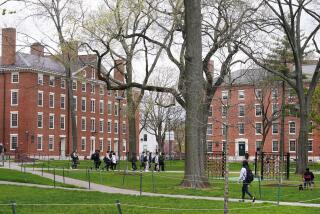Geography Quiz Maps Gap in College Knowledge
- Share via
In 1492, Columbus sailed the ocean blue. And landed . . . uh . . . somewhere.
Cal State Fullerton students Monday could not even find the general area on the map where Columbus first touched land. Only 14% of them could locate the eastern Caribbean Sea area.
Students also struggled with this one: What is the world’s third most populous country? Only 26% knew the answer (the Soviet Union) and then found it on a map. And, only 26% of the students could identify, and then locate, the United States’ leading trade partner, which is . . . ?
No, not Japan. It’s Canada.
Canada? Where’s that?
Scores of students good-naturedly queued up Monday to take a 21-question test given in front of the California State University, Fullerton, Humanities Building. The occasion was the start of National Geography Awareness Week. Geography professor William Puzo devised the test, with prizes and small helium balloons for the contestants.
The colorful games had a serious purpose. Across the nation, educators have expressed growing concern that U.S. students at all levels are appallingly bad at geography.
Susan Munroe, head of the geography education program for the National Geographic Society in Washington, said Monday that such ignorance “is a nationwide problem, from all we can tell. . . .”
“It’s certainly not unique to your students in California,” she said.
Congress, in a joint resolution passed in July, called for more geography awareness by U.S. students. It said that most U.S. college freshmen cannot find Vietnam on a map, even though the country was the site of the longest war in U.S. history. Congress also said that 20% of U.S. elementary-secondary educators who teach geography have taken no classes in the subject.
Cal State Fullerton’s geography department this week is doing its part to change the disturbing trend.
While the results showed some woeful lack of knowledge, Puzo said the students are much better than the average in his classes over the years.
“These kids taking the tests did it voluntarily, and so those not knowing much about geography probably didn’t take the test,” he said.
In 1984, Puzo made headlines when he released the results of testing introductory geography students. Only 49% of the tested students in 1984 could locate Japan.
“I found out from my tests this year that the situation is worse,” Puzo said Monday. “In this year’s tests of my introductory students, only 39% could locate Japan. The 1987 students had lower percentages of correct scores on all geography questions except one. And that’s Cape Town. In 1984-85, 26% of the students could find Cape Town, and this year 29% could find it.”
Puzo said the reason might be that more world attention has focused on South Africa since 1984.
Some students taking Monday’s tests said they wished more geography courses had been available in the lower grades.
“The last time I had a geography class was in grade school,” said Gary Sumner, a management studies major. “There should be something in between--some course you take in high school.”
Ed Merk, a history major, said he did “very badly,” although he wouldn’t give his score.
“This convinces me I’ve got to take a geography class next semester,” he said.
More to Read
Sign up for Essential California
The most important California stories and recommendations in your inbox every morning.
You may occasionally receive promotional content from the Los Angeles Times.













